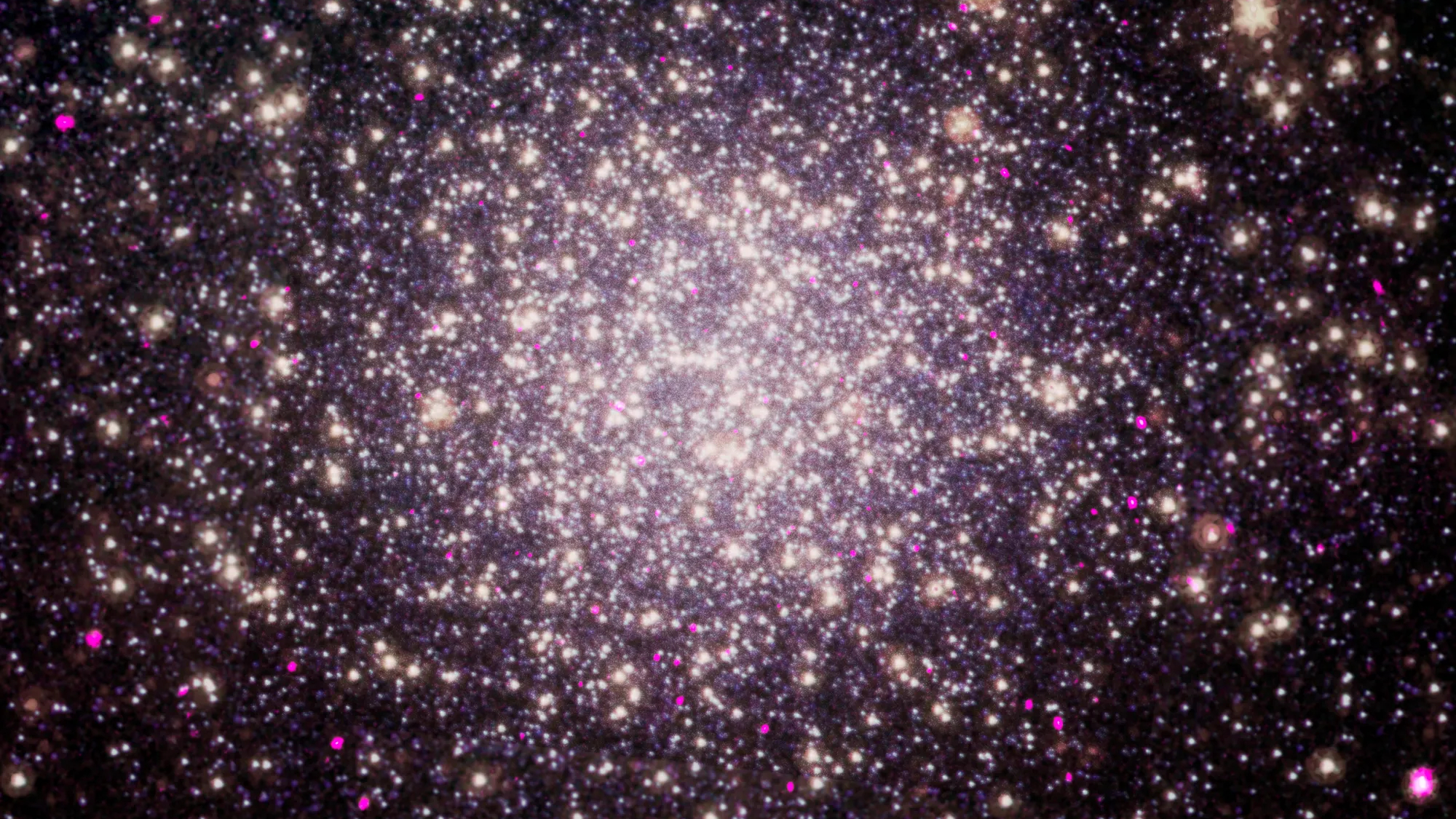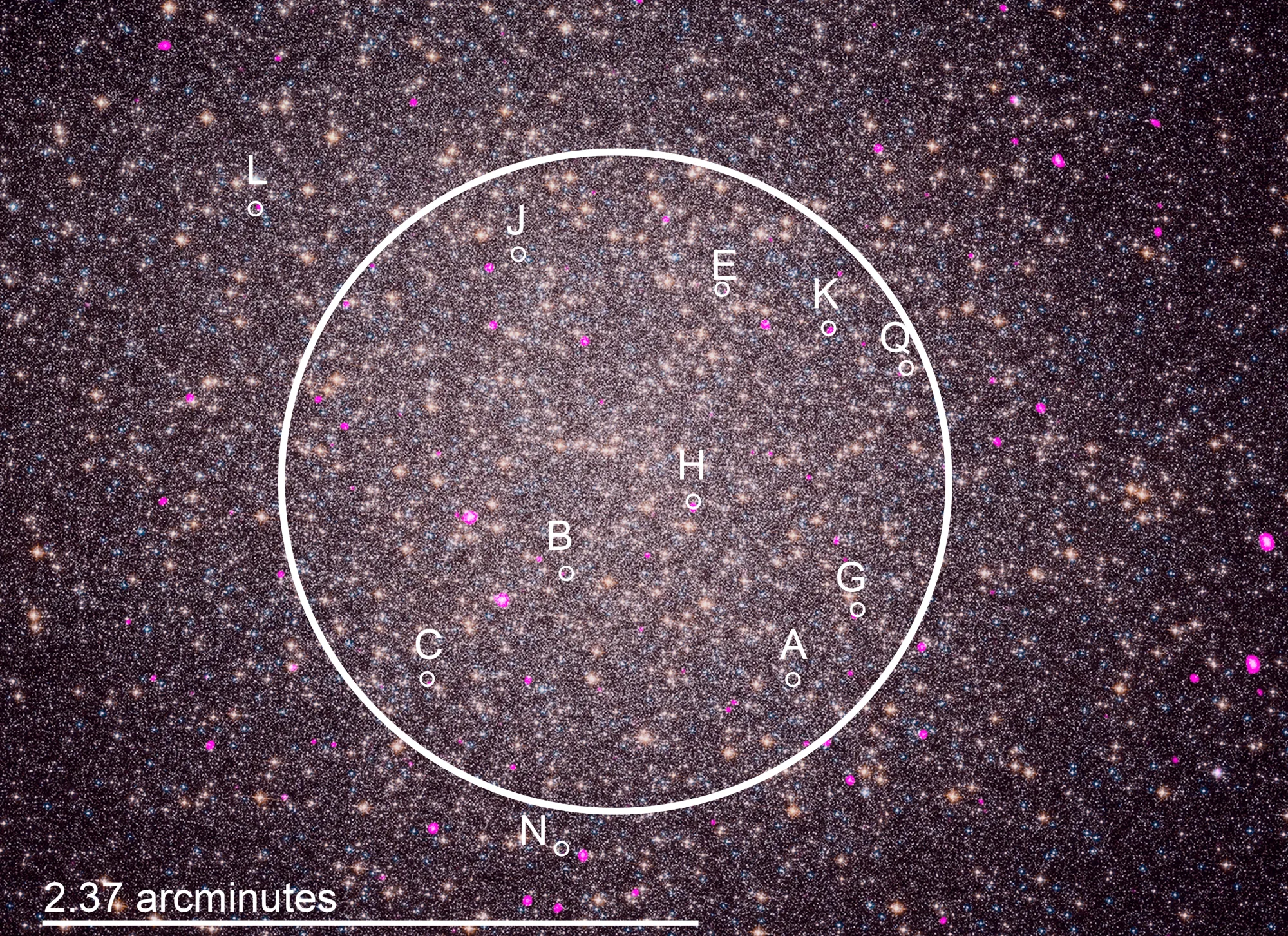
NASA's space-based Chandra X-ray Observatory has watched a "clutter" of spider pulsars devouring their companion stars in the globular cluster Omega Centauri. This data could help scientists better understand how such rapidly spinning neutron stars, named after the arachnids that devour their mates, erode surrounding stars with intense beams of radiation.
The five spider pulsars in this clutter — clutter being the name given to a closely grouped gathering of spiders — were found concentrated at the heart of Omega Centauri, a huge grouping of about 10 million stars located 17,700 light-years from Earth. They were originally uncovered by scientists using the Parkes and MeerKAT radio telescopes who identified a collection of 18 total rapidly spinning neutron stars or "millisecond pulsars."
Researchers from the University of Alberta in Canada identified the quintet of spider pulsars in radio telescope data shortly after realizing that 11 of the 18 were blasting out X-ray radiation. That was a sign that something was up. So, to better understand the cosmic black widow analogs, the team compared the pulsars' radio data to Chandra X-ray observations of 26 spider pulsars in 12 other globular clusters.
Related: 300 gamma-ray-blasting neutron stars found in massive haul — and some are ‘spider pulsars’
"Hatching" from dead stars
Like all neutron stars, spider pulsars are born when massive stars run out of fuel and can no longer sustain nuclear fusion in their cores. This ends the outward flow of energy that had supported the star against the inward pressure of its own gravity for millions, or even billions, of years.
As the outer layers of the dying star (in which nuclear fusion continues) are blasted outward in conjunction with supernova explosions, the stellar cores with masses between one and two times the mass of the sun rapidly collapse to a width of around 12 miles (20 kilometers). This collapse forces electrons and protons together, creating a sea of neutrons — neutral particles normally found at the heart of atoms — that is so dense a tablespoon of it would weigh more than 1 billion tons (900 billion kilograms) . That's about the weight of Mount Everest .
And beyond giving neutron stars the "neutron" part of their name, the collapse has two other significant effects. Just like a figure skater drawing in their arms increases the speed at which they're spinning, the rapid reduction in radius of these dead stellar cores spins them up, allowing some to spin hundreds of times per second. The result? Millisecond pulsars. Some millisecond pulsars even rotate as rapidly as 700 times per second.
Additionally, the gravitational collapse forces together magnetic field lines in the region, intensifying the magnetic field strength of neutron stars to thousands of times that of Earth's magnetic field. These magnetic fields consequently blast out jets of matter that generate beams of radiation; these beams sweep across the universe as the neutron star spins. Think, "cosmic lighthouses."
It is these spinning neutron stars that are called pulsars. And when those pulsar beams of radiation blast surrounding stars, the phenomena are called "spider pulsars."
This destructive process is possible because spider pulsars are typically separated from their companions by a small distance — around 14 times the separation between the Earth and the moon. This relatively close proximity allows energetic particles beamed from the pulsars to eat away their companion stars.
Cosmic redbacks vs. black widows

Spider pulsars are divided into two further arachnid-themed subcategories that are based on their prey. "Redback" spider pulsars deteriorate companion stars with masses between 10% and 50% of the sun, while "black widow" spider pulsars destroy smaller stars with less than 5% of the sun's mass.
But in the team's new investigation, the researchers confirmed another difference between neutron star redbacks and black widows.
They found that redback pulsars are brighter in X-rays than black widow pulsars are. This is the first time the mass of stars getting devoured by spider pulsars has been linked to the radiation that is chewing them away.
This influence is related to particles flowing from the pulsars colliding with winds of material flowing from companion stars, producing shockwaves that generate X-rays — the radiation that further eats away at these stars and the light that Chandra detects . Larger stars, it would appear, create shockwaves that generate more X-rays. That makes redbacks brighter in X-ray light than black widows, the team reasons.
Chandra itself is crucial for investigating spider pulsars and other millisecond pulsars because its sensitive X-ray vision can distinguish between these and other X-ray sources in globular clusters — conglomerations of stars bound together by gravity and increasing in density toward a central point.
This is especially evident in Omega Centauri, where several of the discovered millisecond pulsars are closely crowded by other unrelated X-ray sources.
The team's research will soon be published in the December edition of the journal The Monthly Notices of the Royal Astronomical Society. A preprint version is available on the paper repository arXiv.







